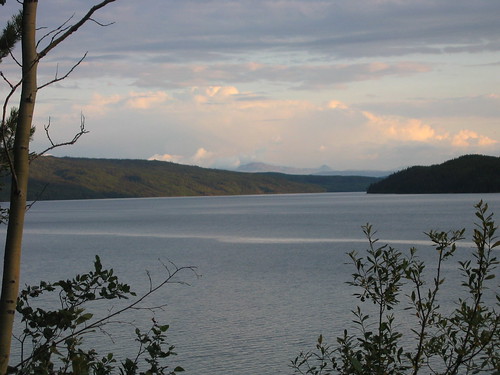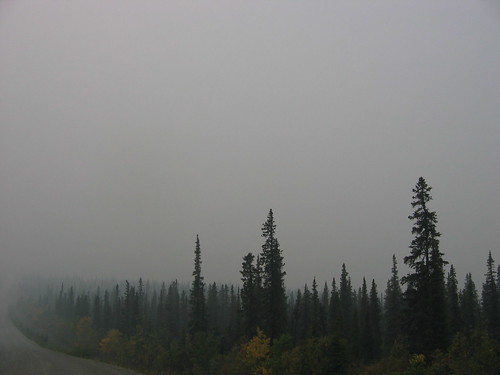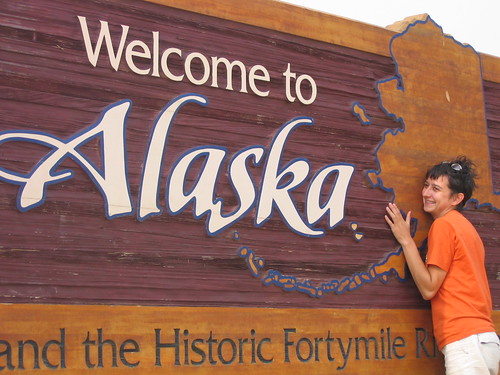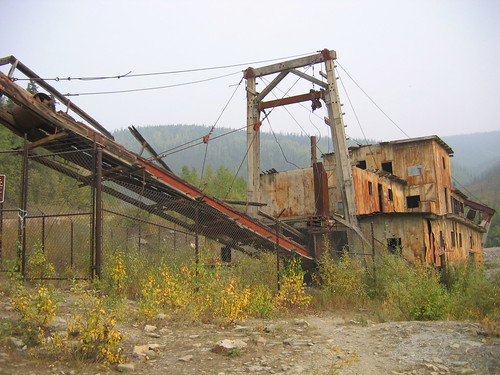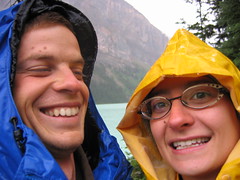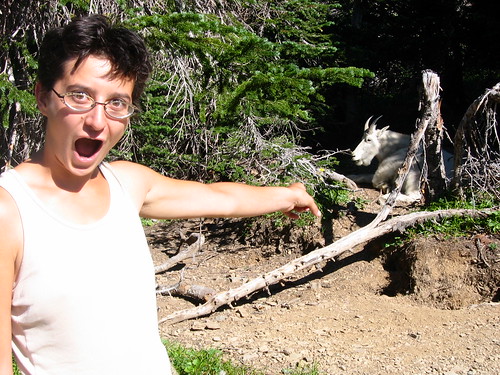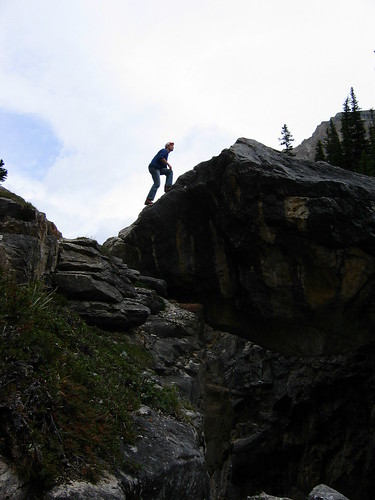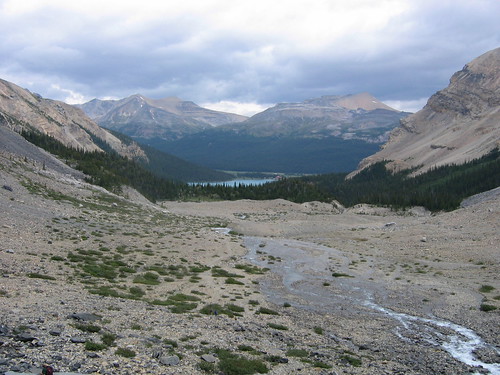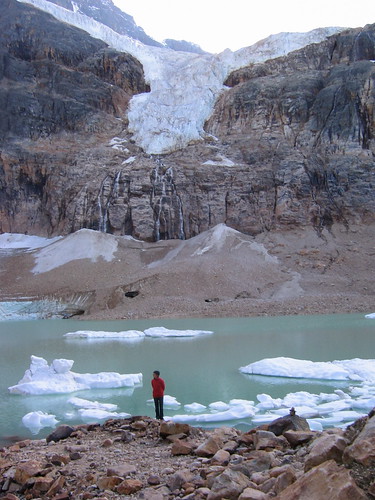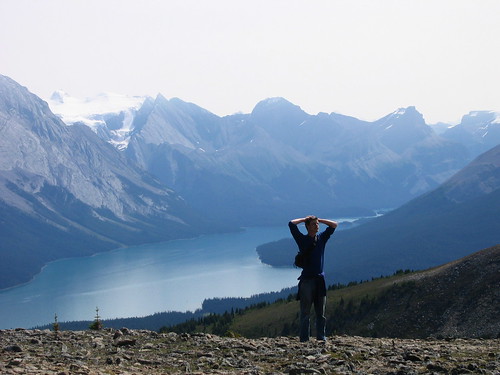Alaksa, Part !!
Update: The battery on my computer has expired, so we golden as long as we can plug in. A new one is being shipped to Spokane for me, but until then, no pre-writing on the road. Posts may thus become a bit shorter in the short term. Apologies, and god love waranties. And now...
Part !!
Should such a thing exist, an epic limerick would be Chicken’s anthem. Beautiful, downtown Chicken, Alaska, consists of a bar, a liquor store (just a window out the bar), a gift shop, the Chicken Café, the chicken coop, and the Chicken Poop (a wheelchair accessible triumvirate of outhouses). But much like the Cassiar Highway was not entirely a highway, “downtown” Chicken doesn’t much resemble any sort of downtown—in part because there’s no “town” for it to be down of. The only other thing in Chicken is an RV park, a gas station, and an airstrip where the mail is flown in and out twice a week. About 20 or 30 people live there in the summer, running these various businesses. The population drops to about zero (give or take) in the winter, when the highways into town are closed and you’re sealed in for eight months.
Downtown is owned and run by Sue, at some point from Pennsylvania. She’s a loud, obnoxious, talkative, braggart of a woman, who is in the process of getting a messy divorce from Gary the Pilot, but is dating Steve the Rich Guy. She shot a huge “boo” (caribou) from 1,000 feet, right between the eyes. Her son was badly burned at the age of 12, or maybe it was 14, and airlifted to Seattle. Her bartender is named Randy, and was in Fairbanks when we arrived, so she was parked behind the counter covered in graffiti etchings—this is how we know so much about Sue, although she’d probably tell you all of it within any hourlong conversation. Especially the part about the caribou. She wakes up at 5 AM and makes trays of cookies, pies, and muffins to feed the tour busses full of people that stop in during the summer. That’s why the Chicken Poop is wheelchair accessible—to appease the tour companies who bring in a huge chunk of revenue to Sue’s business, which only runs four months of the year.
Also living in Chicken were Gary and Matt. Matt is our age, and decided to hop on a plane to Alaska in May, never having been there before. He ended up working for Sue—the day we were there, he was line cook, bartender, kitchen hand, and dishwasher and worked from 7 AM to at least 11 PM when we went to bed. Gary was a Marine for 40 years, and is now something of a hippy. He lives in a school bus that he rigged up with a sauna, and has long grey hair and a thick beard. He was shot in the head in Vietnam and is trying to convince the government that he’s crazy (which, objectively, he kind of is). Apparently they keep telling him that loss of memory, insomnia (he sleeps two hours a night), and a change in his personality don’t have anything to do with being shot in the head. He says he’s almost got them convinced, though. Gary’s been in Alaska for five years, and loves it. He also works for Sue, doing almost the same things as Matt does, in addition to operating “the canon.” He’s sweet like a child is, but a little mischievous. His experience in the Marines taught him to love artillery fire in general, and gunpowder in particular. Once we’d been parked in the bar for about two hours, Gary mentioned a novel way to get a free drink. Take off your panties and pack them into the canon with about 7 packs of gunpowder. Aim, fire, and booze. The remnants of one of my favorite pairs of Betty-Boop polka-dotted undies are now stapled above the bar, along with about 400 other scraps, numerous men’s ballcaps, and thousands of notes, business cards, and dollar bills with people’s names and home places scrawled on them. Mine say: Hanna (D.C.) in thick black permanent marker.
In the Chicken Saloon, which was recommended to us by a friend who’d passed by two years prior, we parked ourselves at about 5pm, Alaska time (they have their own time zone up here). For a while, we were ignored as Sue and some folks from Wasilla (near Anchorage) chatted about divorce, hunting, and Captain Morgan. Drinking the local brew from the tap marked us as passers-through, “bourgie” tourists, east coasters out on a whim. Once we opened a tab though, and started in with the MGD, the locals opened up a bit. We made friends with another Gary and his wife (name unremembered)—two of the hardest drinking people I’ve ever met. Gary works construction on bridges and docks, and had worked winters in Prudoe Bay (the Alaska Pipeline’s northern terminus in the Arctic Circle), where it can get down to more than 100 degrees below zero. After a few rounds he brought out the best salmon dip I’d ever had (which he made from Alaskan red salmon he’d caught this summer), and a smoked terryaki salmon that tasted like an orgy of sweetness. They complained about the Lower 48ers, who brought their laws with them to the wilderness—primarily, seatbelt and gun laws. He and wifey were in Chicken hunting caribou before the season closed. He indicated he had many guns, she indicated that handguns were her personal favorite. He was incredulous when we told him that Washington, D.C. doesn’t have bears. “No? You gotta have some bears, somewhere. Can’t have no bears,” he said. It was hard to convince him that the nearest bears were in the zoo, and the second nearest were in Wyoming. The conversation degenerated as we continued drinking, mostly to talk of looooove. They were really in loooove. He used to “hate women and everything about em, until I met this firecracker here.” They (she especially) were really happy we were in loooove too. She loooooved our looooove. We danced a drunk dance to the jukebox (the numbers don’t correspond to the songs they say they do, it just plays whatever it wants – I think 237 got us Janis Joplin), and stumbled out.
The Chicken staff, enamoured of us now that our tab was good and deep, wouldn’t hear talk of pitching a tent in the parking lot or sleeping in the truck. Nope, they had a little cabin, empty for the night, and we would stay there. A little single bed, but Gary thought the two of us were skinny enough to fit comfortably on it. The other cabin, with a wood stove, was airing out from a previous drinker’s expurgations.
We slept like babies, our first night in a bed since Hamilton, Montana. Sue woke us up at dawn, yelling at Gary for forgetting to cap the generator, and was yelling at him again at breakfast for burning the cookies (“I won’t catch that hell again,” he said when she left the room). I think there might be something to memory loss and a gunshot to the back of the head, but hey, I’m not the VA.
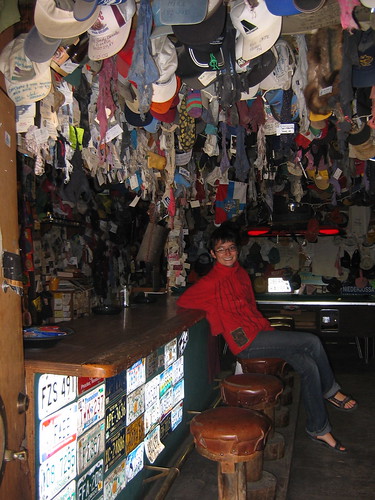
Hanna in the Chicken Saloon. You can see I'm not the only one to dismember her panties. We have action shots of the canon firing, but they're a bit dark and a bit personal. By request only.
Next up: the Denali Highway; and then: Denali National Park; and then: Anchorage!
Part !!
Should such a thing exist, an epic limerick would be Chicken’s anthem. Beautiful, downtown Chicken, Alaska, consists of a bar, a liquor store (just a window out the bar), a gift shop, the Chicken Café, the chicken coop, and the Chicken Poop (a wheelchair accessible triumvirate of outhouses). But much like the Cassiar Highway was not entirely a highway, “downtown” Chicken doesn’t much resemble any sort of downtown—in part because there’s no “town” for it to be down of. The only other thing in Chicken is an RV park, a gas station, and an airstrip where the mail is flown in and out twice a week. About 20 or 30 people live there in the summer, running these various businesses. The population drops to about zero (give or take) in the winter, when the highways into town are closed and you’re sealed in for eight months.
Downtown is owned and run by Sue, at some point from Pennsylvania. She’s a loud, obnoxious, talkative, braggart of a woman, who is in the process of getting a messy divorce from Gary the Pilot, but is dating Steve the Rich Guy. She shot a huge “boo” (caribou) from 1,000 feet, right between the eyes. Her son was badly burned at the age of 12, or maybe it was 14, and airlifted to Seattle. Her bartender is named Randy, and was in Fairbanks when we arrived, so she was parked behind the counter covered in graffiti etchings—this is how we know so much about Sue, although she’d probably tell you all of it within any hourlong conversation. Especially the part about the caribou. She wakes up at 5 AM and makes trays of cookies, pies, and muffins to feed the tour busses full of people that stop in during the summer. That’s why the Chicken Poop is wheelchair accessible—to appease the tour companies who bring in a huge chunk of revenue to Sue’s business, which only runs four months of the year.
Also living in Chicken were Gary and Matt. Matt is our age, and decided to hop on a plane to Alaska in May, never having been there before. He ended up working for Sue—the day we were there, he was line cook, bartender, kitchen hand, and dishwasher and worked from 7 AM to at least 11 PM when we went to bed. Gary was a Marine for 40 years, and is now something of a hippy. He lives in a school bus that he rigged up with a sauna, and has long grey hair and a thick beard. He was shot in the head in Vietnam and is trying to convince the government that he’s crazy (which, objectively, he kind of is). Apparently they keep telling him that loss of memory, insomnia (he sleeps two hours a night), and a change in his personality don’t have anything to do with being shot in the head. He says he’s almost got them convinced, though. Gary’s been in Alaska for five years, and loves it. He also works for Sue, doing almost the same things as Matt does, in addition to operating “the canon.” He’s sweet like a child is, but a little mischievous. His experience in the Marines taught him to love artillery fire in general, and gunpowder in particular. Once we’d been parked in the bar for about two hours, Gary mentioned a novel way to get a free drink. Take off your panties and pack them into the canon with about 7 packs of gunpowder. Aim, fire, and booze. The remnants of one of my favorite pairs of Betty-Boop polka-dotted undies are now stapled above the bar, along with about 400 other scraps, numerous men’s ballcaps, and thousands of notes, business cards, and dollar bills with people’s names and home places scrawled on them. Mine say: Hanna (D.C.) in thick black permanent marker.
In the Chicken Saloon, which was recommended to us by a friend who’d passed by two years prior, we parked ourselves at about 5pm, Alaska time (they have their own time zone up here). For a while, we were ignored as Sue and some folks from Wasilla (near Anchorage) chatted about divorce, hunting, and Captain Morgan. Drinking the local brew from the tap marked us as passers-through, “bourgie” tourists, east coasters out on a whim. Once we opened a tab though, and started in with the MGD, the locals opened up a bit. We made friends with another Gary and his wife (name unremembered)—two of the hardest drinking people I’ve ever met. Gary works construction on bridges and docks, and had worked winters in Prudoe Bay (the Alaska Pipeline’s northern terminus in the Arctic Circle), where it can get down to more than 100 degrees below zero. After a few rounds he brought out the best salmon dip I’d ever had (which he made from Alaskan red salmon he’d caught this summer), and a smoked terryaki salmon that tasted like an orgy of sweetness. They complained about the Lower 48ers, who brought their laws with them to the wilderness—primarily, seatbelt and gun laws. He and wifey were in Chicken hunting caribou before the season closed. He indicated he had many guns, she indicated that handguns were her personal favorite. He was incredulous when we told him that Washington, D.C. doesn’t have bears. “No? You gotta have some bears, somewhere. Can’t have no bears,” he said. It was hard to convince him that the nearest bears were in the zoo, and the second nearest were in Wyoming. The conversation degenerated as we continued drinking, mostly to talk of looooove. They were really in loooove. He used to “hate women and everything about em, until I met this firecracker here.” They (she especially) were really happy we were in loooove too. She loooooved our looooove. We danced a drunk dance to the jukebox (the numbers don’t correspond to the songs they say they do, it just plays whatever it wants – I think 237 got us Janis Joplin), and stumbled out.
The Chicken staff, enamoured of us now that our tab was good and deep, wouldn’t hear talk of pitching a tent in the parking lot or sleeping in the truck. Nope, they had a little cabin, empty for the night, and we would stay there. A little single bed, but Gary thought the two of us were skinny enough to fit comfortably on it. The other cabin, with a wood stove, was airing out from a previous drinker’s expurgations.
We slept like babies, our first night in a bed since Hamilton, Montana. Sue woke us up at dawn, yelling at Gary for forgetting to cap the generator, and was yelling at him again at breakfast for burning the cookies (“I won’t catch that hell again,” he said when she left the room). I think there might be something to memory loss and a gunshot to the back of the head, but hey, I’m not the VA.

Hanna in the Chicken Saloon. You can see I'm not the only one to dismember her panties. We have action shots of the canon firing, but they're a bit dark and a bit personal. By request only.
Next up: the Denali Highway; and then: Denali National Park; and then: Anchorage!
